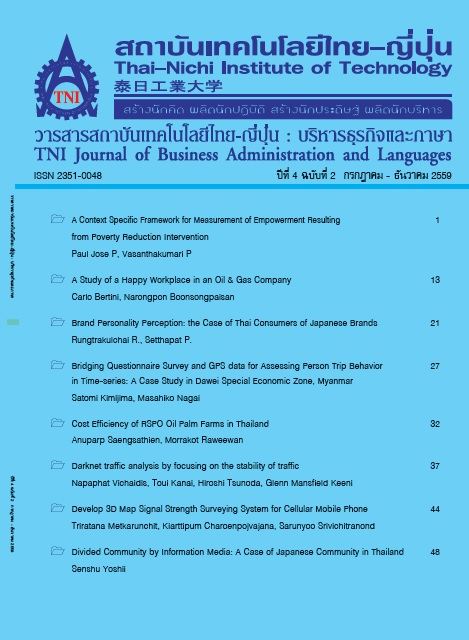Develop 3D Map Signal Strength Surveying System for Cellular Mobile Phone
Main Article Content
Abstract
The purpose of this research is to develop a 3D map signal strength surveying system for cellular mobile phone. Currently, the traditional cellular signal surveying is generally done by walking or driving while carrying the measurement device which greatly limited the surveying area. The survey in this research uses new method, by using a 250mm quadcopter with an application-installed mobile phone, so it can easily measure the signal strength. The application on the mobile phone is used to measure the signal strength, latitude/longitude coordinate and timestamp, send it to the server via cellular network in real-time, and also store it into local database. The quadcopter also has a barometer and GPS (global positioning system) installed. This information can be accessed by GCS (ground control station) via radio link. This system uses information from both mobile phone and GCS, display it in form of 3D signal strength map that will benefit for quality of service of cellular mobile networks.
Article Details
Article Accepting Policy
The editorial board of Thai-Nichi Institute of Technology is pleased to receive articles from lecturers and experts in the fields of business administration, languages, engineering and technology written in Thai or English. The academic work submitted for publication must not be published in any other publication before and must not be under consideration of other journal submissions. Therefore, those interested in participating in the dissemination of work and knowledge can submit their article to the editorial board for further submission to the screening committee to consider publishing in the journal. The articles that can be published include solely research articles. Interested persons can prepare their articles by reviewing recommendations for article authors.
Copyright infringement is solely the responsibility of the author(s) of the article. Articles that have been published must be screened and reviewed for quality from qualified experts approved by the editorial board.
The text that appears within each article published in this research journal is a personal opinion of each author, nothing related to Thai-Nichi Institute of Technology, and other faculty members in the institution in any way. Responsibilities and accuracy for the content of each article are owned by each author. If there is any mistake, each author will be responsible for his/her own article(s).
The editorial board reserves the right not to bring any content, views or comments of articles in the Journal of Thai-Nichi Institute of Technology to publish before receiving permission from the authorized author(s) in writing. The published work is the copyright of the Journal of Thai-Nichi Institute of Technology.
References
A. R. Mishra, Fundamentals of Cellular Network Planning and Optimisation: 2G/2.5G/3G…Evolution to 4G. West Sussex, England: Wiley, 2004.
S. Von Watzdorf and F. Michahelles, “Accuracy of Positioning Data on Smartphones,” in Proceedings of the 3rd International Workshop on Location and the Web, New York, USA, 2010, pp. 1-4.
P. Barry and R. Coakley, “Field Accuracy Test of RPAS Photogrammetry,” Council for European Studies, 2013. [Online]. Available: https://ec.europa.eu /eusurvey/files/acd0dca7-2e40-4604-99ab-98bfaa7ccd06.
“DJI,” PHANTOM 4 User Manual v1.2, 2016. [Online]. Available: https://dl.djicdn.com/downloads/phantom_4/en/Phanto m_4_User_Manual_en_v1.2_160328.pdf.
K. S. Yen, M. T. Darter, H. Nguyen, B. Ravani, and T. A. Lasky, “Aerial Sensing and Characterization of Three-Dimensional RF Fields,” University of California at Davis, Davis, CA., 2014.
E. Teng, J. D. Falcao, C. R. Dominguez, F. Mokaya, P. Zhang, and B. Iannucci, “Aerial Sensing and Characterization of Three-Dimensional RF Fields,” in Second International Workshop on Robotic Sensor Networks, 2015.


